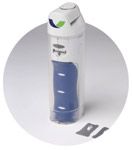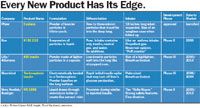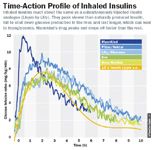Holding Their Breath: Inhaled Insulin
Pharmaceutical Executive
All of the companies with inhaled-insulin drugs must perform two-year safety studies. Not because their drugs show troubling data, but because Exubera has caused slight, temporary decreases in lung function.
Four new inhaled-insulin therapies are following Exubera (insulin) down the drug pipeline, and each one of them may eventually enjoy a significant advantage over Pfizer's groundbreaking new delivery system. But for now, Pfizer has the only drug in its class. The new inhalation system, originally developed by Nektar Therapeutics of San Carlos, California, shows a similar insulin profile to subcutaneously injected insulin, and has proven popular with patients during clinical trials. Although the drug's price had not been set at press time, strong patient uptake is fairly well assured. In part because the world's largest pharmaceutical company will put its marketing muscle behind it. But also because pulmonary delivery could boost compliance among patients who resist treatment because they fear needles or hate injections.

Exubera by Pfizer/Nektar has the inhaled insulin market all to itself-for the next two or three years. With peak sales of $3 billion worldwide by 2013, says Wolters Kluwer, it's a "new delivery" blockbuster. The insulin is the same. But the compact inhaler allows patients to draw the drug into their blood through the lungs-without ever touching a needle.
No one is rooting harder for Exubera than manufacturers of inhaled-insulin therapies in late-stage clinical trials: Kos Pharmaceuticals, Mannkind Corporation, Novo Nordisk (which partners with Aradigm, based in Hayward, California), and Eli Lilly (which teamed up with Boston-base Alkermes). Nothing would have been worse for these companies than FDA's failure to approve Pfizer's drug. And now that Exubera is launched, few outcomes could derail the new products faster than a major setback for their biggest competitor. If Exubera puts physicians and patients at ease about the new insulin delivery system—and satisfies FDA that the new technology is safe—it will create a new market, for which all future inhaled-insulin products will compete.

"I think it's good to have somebody like Pfizer coming first with all their power," says Ralf Rosskamp, MD, executive vice president, research and development at Kos Pharmaceuticals, based in Cranbury, New Jersey. "They will make sure people understand how inhaled insulins are used, how good they are for patients. They pave the way. And in the end, it's the patient's decision, then, if he sees different kinds of devices and makes a change later."

But even as the new companies hope for Pfizer's early success, they have begun to measure themselves against each other and, ultimately, against the market leader. So far, there are several major points of difference: the formulation of the drug, the size and convenience of the inhaler, the precision and ease of dosing, the safety of the product, and in the case of one product, the bioavailability of the insulin itself. No one company has the advantage in all of these areas, and since many patients may find one or another quality most important, it is unclear which product besides Exubera will gain the upper hand.

Every New Product Has Its Edge.
The Formulation
Most discussions begin with differences in the formulation of the insulin delivered by the inhaler. Kos and Novo Nordisk/Aradigm have liquid solutions—or, perhaps more accurately, suspensions—of recombinant human insulin, the same basic drug used in all five medications. Lilly/Alkermes and Mannkind use a powder, but both companies distinguish their powder formulations from the "heavy" particles of Pfizer. Lilly/Alkermes scientists like to compare Pfizer's "baseballs" to the "popcorn kernels" they developed. Pfizer's particles are one to three microns in diameter, a size that is designed to penetrate the alveoli of the deep lung, and that is explicitly protected in Nektar's original intellectual property. They also are fairly dense. Like baseballs, they travel far once they are set in motion.

Time-Action Profile of Inhaled Insulins
Lilly/Alkermes' particles are light and airy like popcorn kernels. "We engineered the particles," said Bernard Silverman, MD, vice president, clinical development at Alkermes. "We changed the geometric configuration of our particles so that some of them under a scanning electron microscope look like crumpled paper and others like a hollow ball." Like popcorn in an air popper, the kernels that expand the most and have the least density fly the farthest. The Lilly/Alkermes particles are larger than Pfizer's particles, about 10 microns, but they are light in weight and still can penetrate the deep lung.
Mannkind, based in Valencia, California, uses a substrate that looks something like an airy, round shower sponge. The substrate—Mannkind calls it a Technosphere—has a slight positive charge and creates an electrostatic bond to the negatively charged insulin peptides, which cling to it by the thousand. The Technosphere remains a particle as long as the pH of its environment stays slightly acidic, so it can be drawn into the lungs as powder. But in the moist, neutral-pH environment of the deep lung, the particle liquefies and easily penetrates the lung membranes.
More provocatively, Mannkind executives claim that the unique substrate binds human recombinant insulin as monomers, or single peptides, instead of as hexamers, or configurations of six insulin molecules. "Because of our delivery platform, you get the insulin into the blood very quickly," explains Hakan Edstrom, the President and COO of Mannkind. "You get insulin into the blood in monomeric form, which means it can immediately start to exert its influence on the blood glucose, whereas the other insulin breaks down from a hexamer, to a dimer, then to a monomer before it can actually start to work." This causes the insulin level in the blood to rise faster than with other insulin medications, including fast-acting insulin analogues.
Jay S. Skyler, MD, professor of medicine at the University of Miami, says the data from several independent studies show that Mannkind's system does make insulin available more rapidly than other inhaled or injected products, but he remains agnostic about the mechanism until additional studies are completed.
However, Skyler notes that the insulin profile of Mannkind's product resembles that of a healthy person more than that of any other insulin product on the market. At the beginning of a meal, he notes, the pancreas of a non-diabetic creates a sharp spike of insulin that signals the liver to shut down glucose production. "Most diabetics lack that rapid response of insulin secretion from the pancreas," says Skyler, who notes that injected and inhaled insulin also act too slowly to shut down the liver. "So the liver continues to make glucose, and the total burden of glucose after a meal is much higher in somebody with diabetes than for somebody else when they eat the very same meal."
Ultimately, Mannkind's product may be the only one to change the way doctors think about diabetes, says Skyler, who has been a paid consultant for all of the companies with products discussed in this article. "Mannkind may demonstrate that there really is a way to deliver a burst of insulin very quickly, because it doesn't take that much to shut down the liver. That's the only place where I see these products having a real difference in metabolism as opposed to a difference in convenience, so far."
Kos and Novo Nordisk/Aradigm have developed liquid formulas. "The difference to most other formulations is that we are basing it on the same paradigm as asthma devices," said Kos Pharmaceutical's Rosskamp. "Asthma formulations just contain the propellant plus the actual drug, which usually is a steroid or another drug. So ours is only the propellant—HFA, which is a [environmentally] friendly gas—plus the insulin [and a little water]. If you really want to say it correctly, they are in a suspension form. But I think aerosol liquid would also be the right way to characterize it."
Rosskamp also emphasizes that Kos's insulin contains no additives or preservatives, which in his view differentiates it from the powders, which contain non-insulin excipients or preservatives.
NovoNordisk and Aradigm, on the other hand, begin with a powder that is heated with liquid in the chamber of the inhaler and drawn through laser-drilled holes that are one micron in diameter. This creates an aerosol mist of two-to three-micron droplets.
The Device
Next to formulation, the convenience, reliability, and size of the inhaler are likely to be among the key factors driving patient demand.
"We know from Pfizer's reports and also from various photographs that Exubera has a reasonable- size device," said Jane Kidd, principal analyst with Wood Mackenzie in Edinborough, Scotland. The Pfizer inhaler folds to roughly the size of an eyeglass case, but extends to about 10 inches in length when in use. "Anybody that can come onto the market with a delivery device that is smaller, easier to use, easier to maintain, possibly disposable—but that can ensure the patient will have good delivery of the insulin—will be in a far more favorable position than Pfizer."
But at least one inhaler could succeed with precision dosing. Trials may confirm that the Novo Nordisk inhaler can titrate doses to one unit of insulin, which is a level of precision usually associated with injected insulin, but finer than the three-unit dosages typical of the Exubera and Lilly/Alkermes devices. This, at least, was the goal originally proposed by Aradigm.
"Theoretically they can titrate to one unit," says Skyler. "Novo Nordisk also has a lot of bells and whistles to assure safety. They've gone out and built a Rolls-Royce. They function as well as a Rolls-Royce in relation to other vehicles, but there's not a big market for the Rolls-Royce." Aradigm referred questions about the system to Novo Nordisk, which declined repeated requests for an interview, noting in an e-mail only that "we expect to confirm reinitiation of our Phase III clinical trials during Q1 2006." Sources suggest that the trials were suspended for a pharmacokinetic/pharmacodynamic-dosing study.
In general, inhalers are shaping up to be smaller than Pfizer's. Because Lilly/Alkermes relies on the lightness of the particle, it was able to create a small inhaler powered by the patient's breath. Lilly's marketing materials describe the inhaler as about the size of a highlighter. A capsule of insulin powder is placed into the inhaler and broken open when the inhaler is compressed. At that point, the patient draws air through the inhaler to propel insulin particles into the lungs. According to Alkermes, the insulin enters the mouth early in the breath, so that the full dose is achieved even with a relatively small breath.
"In the range from a normal breath in to a forceful breath in, we don't have a lot of variation in the amount of insulin delivered," said Alkermes's Silverman. "It's more like swallowing a pill with water. You need a little water to get the pill down. But even if you drink a gallon more after that, it doesn't matter. The pill is already in your stomach."
The Mannkind inhaler also is just larger than the palm of a hand in the closed position, but nearly doubles in length when the mouthpiece unfolds.
The Kos inhaler, like the asthma inhalers it was modeled on, works with a propellant gas. The insulin, mixed with just water and gas, never requires refrigeration. Unlike other inhalers, which must be loaded with a dose of insulin from a capsule or blister pack every time they are used, the Kos inhaler has a reservoir of 120 "puffs" of insulin. A puff counter calibrates dosing and keeps track of the remaining supply of insulin on a small digital display. If a patient knows he needs about six or seven puffs a day, he can check the puff counter to determine how long his supply will last.
Safety
All of the companies benefit when Pfizer, the mega-marketer, begins selling doctors and patients on the new approach to therapy. But developers at the four companies with drugs in clinical trials also are obliged to answer questions that, so far, have been raised only by Pfizer's product. Each of the other companies, for instance, must build into their Phase-III clinical trials a two-year safety study. Not because they have shown any negative data, but because Pfizer and Nektar's drug, which is formulated differently from their own, was linked to a slight and temporary decrease in lung function. Pfizer has agreed to begin a five-year post-launch surveillance study of 5,000 patients that is expected to confirm what the FDA advisory panel already documented: a temporary decrease in lung function that stabilized within six months, did not progress, and was reversible when the drug was discontinued. Ironically, the extra study required by FDA extends the time that Exubera has sole possession of the market.
"Right now they're telling everybody who wants to develop an inhaled insulin, you have to have two years' data" says Rosskamp. "Because right now they're assuming that everybody will see this lung function decline, which Exubera has seen in their clinical trials." FDA requires Kos to begin with a certain number of patients (which it declines to reveal) for the initial six-month study and to retain some of them for a year, and a final group for another year. FDA officials declined to be interviewed for this article.
Kos and, less explicitly, Mannkind, have indicated that they believe this extended safety trial may not prove necessary for their drug. Each company hopes that its formulation, which has no excipients, will prove less irritating to the lungs than Exubera. Rosskamp made the case most directly: "One of the strategies which we try to pursue with the FDA is, if we show that after six or 12 months we do not observe this decline, then we wouldn't need two years' data. So we could file earlier. That's something, of course, which we'll have to discuss with them."
However the safety study works out, none of the new products is likely to reach the market before 2008. And if they must complete the full two-year trial, manufacturers may not launch until 2009 or 2010. Until then, Exubera's performance in the marketplace is likely to matter more than the drug candidates' results in clinical trials.
"Exubera has much to prove on the inhaled-insulin market," says Wood Mackenzie's Kidd. "Not only for Pfizer, but also for some of the guys that are hoping to be fast followers. If Exubera falls flat on its face, they will face a very tough challenge to reinvigorate the market and gain patient and physician confidence again."

Addressing Disparities in Psoriasis Trials: Takeda's Strategies for Inclusivity in Clinical Research
April 14th 2025LaShell Robinson, Head of Global Feasibility and Trial Equity at Takeda, speaks about the company's strategies to engage patients in underrepresented populations in its phase III psoriasis trials.
Bristol Myers Squibb’s Cobenfy Falls Short in Phase III Trial as Add On Therapy for Schizophrenia
April 23rd 2025In the Phase III ARISE trial, Cobenfy administered as an adjunctive treatment to atypical antipsychotics for patients with inadequately controlled schizophrenia did not achieve statistically significant improvements.
Key Findings of the NIAGARA and HIMALAYA Trials
November 8th 2024In this episode of the Pharmaceutical Executive podcast, Shubh Goel, head of immuno-oncology, gastrointestinal tumors, US oncology business unit, AstraZeneca, discusses the findings of the NIAGARA trial in bladder cancer and the significance of the five-year overall survival data from the HIMALAYA trial, particularly the long-term efficacy of the STRIDE regimen for unresectable liver cancer.
Expanding Immune Response Testing to Support Vaccine Development
April 22nd 2025Nigel McCracken, chief operating officer, Virax Biolabs, discusses the expansion of its ViraxImmune platform into areas such as transplant monitoring, vaccine efficacy, latent virus reactivation, and CAR T cell therapy.